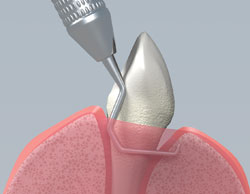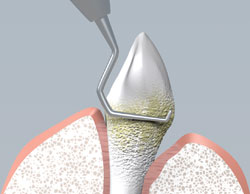Periodontal Disease
What is periodontal disease?
Periodontal (perry-o-DON-tal) disease is an infection that affects the tissues and bone that support teeth.
Healthy gum tissue fits like a cuff around each tooth. When someone has periodontal disease, the gum tissue pulls away from the tooth. As the disease worsens, the tissue and bone that support the tooth are destroyed. Over time, teeth may fall out or need to be removed. Treating periodontal disease in the early stages can help prevent tooth loss.
Periodontal disease and whole-body health
Tooth loss is not the only possible problem posed by periodontal diseases. There may be a link between periodontal disease and cardiovascular disease (heart disease and stroke). High stress may also be linked to periodontal disease. Researchers are still studying these links.
How do I know if I have periodontal disease?
It can be hard to know. You can have periodontal disease without clear symptoms. That’s why regular dental checkups and periodontal examinations are very important.
Several warning signs can signal a problem. If you notice any of the following, see your dentist:
- gums that bleed when you brush or floss
- red, swollen, or tender gums
- gums that have pulled away from your teeth
- bad breath that doesn’t go away
- pus between the teeth and gums
- loose or separating teeth
- a change in the way your teeth fit together when you bite
- a change in the fit of partial dentures
What causes periodontal diseases?
Periodontal diseases are caused by plaque (rhymes with “back”), a sticky film that is always forming on your teeth. Plaque contains bacteria that produce harmful toxins. If teeth are not cleaned well, the toxins can irritate and inflame the gums.
Inflamed gums can pull away from the teeth and form spaces called pockets. The pockets trap plaque and bacteria which cannot be removed with brushing. The gums can become infected. If the infected pockets are not treated, the disease can get worse. The bone and other tissues that support teeth are damaged.
Brush your teeth twice a day and floss (or use another between-the-teeth cleaner) daily. If plaque stays on teeth, it can harden into a rough surface called tartar. Tartar can only be removed when teeth are cleaned at the dental office.
How do periodontal diseases develop?
Gingivitis (jin-ja-VY-tis) is the early stage of periodontal disease. Affected gum areas become red. They may appear swollen and may bleed easily, especially when you brush or floss your teeth. The condition is reversible at this stage with a professional cleaning at your dentist’s office, and regular brushing and flossing. If it is not treated, however, gingivitis may lead to a more serious condition called periodontitis (perry-oh-don-TIE-tis).
Periodontitis can do lasting damage to the gums, bones and other structures that support the teeth. However, treatment can help. At more advanced stages, the disease may require more complex treatment to prevent tooth loss. In the worst case, teeth can become loose and need to be removed by the dentist. How periodontitis is treated depends on how far the condition has developed and how well your body responds to therapy over time.
Diseases such as diabetes, blood cell disorders, HIV infections, and AIDS can lower the body’s resistance to infection. This can place a person at greater risk for more severe forms of periodontal diseases. Smoking may also increase your risk of developing periodontal disease, and treatment may be less successful if you continue to smoke.
Stages of Periodontal Diseases
How are periodontal diseases diagnosed?
If you schedule regular dental exams, your dentist can catch periodontal diseases before the gums and the bone supporting your teeth are severely damaged. If left untreated, periodontal diseases usually get worse over time.
During a periodontal exam, the dentist checks your gums for problems. The dentist or hygienist uses an instrument called a periodontal probe to gently measure the depth of the spaces between your teeth and gums. In a healthy mouth, this space is very small, less than three millimeters. When periodontal disease is present, the gums develop a deeper pocket that bleeds, collects more plaque bacteria, and is difficult to keep clean.
Besides checking your gums, your dentist will assess your general dental health, and perform an oral cancer screening. Dental X-rays are usually taken to check the condition of bone supporting the teeth and to detect other problems not visible during the clinical examination.
If gum disease is diagnosed, your dentist may provide treatment, or you may be referred to a periodontist (a dentist who specializes in the diagnosis, prevention and treatment of periodontal diseases).
How are periodontal diseases treated?
Periodontal treatment methods depend upon the type and severity of the disease. If the disease is caught early (when it is gingivitis), and no damage has been done to the supporting structures under the teeth, you may simply be given instructions on improving your daily oral hygiene after having a professional cleaning.
Even with these measures, some patients develop more severe periodontal disease that must be treated. The first step usually involves a special cleaning, called scaling and root planing. In this treatment, plaque and tartar are carefully removed down to the bottom of each periodontal pocket. This treatment may be done over several visits, depending on your needs. The tooth’s root surfaces are then smoothed, or planed, to allow the gum tissue to heal and reattach to the tooth. This is sometimes called “periodontal cleaning” or “deep cleaning” and may take more than one visit.
Your dentist also may recommend medications to help control infection and pain, or to aid healing. These medications could include a pill, a mouthrinse, or a substance that the dentist places directly in the periodontal pocket after scaling and root planing. If you smoke or chew tobacco products, it is important to quit. Your dentist may also advise you to talk to your physician about any other health problems that may be affecting your oral health.
Once the scaling and root planing treatment is complete, another appointment will be made within a few weeks. At this appointment, the dentist or hygienist will look at your gums to see how they have healed and measure the periodontal pockets again. If the disease continues to advance to the point where the periodontal pockets get deeper and the supporting bone is lost, more treatment may be necessary.
Periodontitis will not go away by itself. Left untreated, surgery may be needed to save affected teeth. Preventing and treating the disease in the early stages are the best ways to keep your smile healthy.
Subgingival scaling removes plaque and tartar from below the gum line.

Root planing smoothes the tooth root and helps the gums re-attach to the tooth.

Care after treatment
Once your periodontal treatment is completed, your dentist may recommend more frequent checkups. Regular dental visits and deep cleanings are important to keep periodontal disease under control. In some cases, your appointments may alternate between your general dentist and a periodontist.
Good oral hygiene at home is also important to help keep periodontal disease from becoming more serious or from coming back. It just takes a few minutes twice a day to care for your teeth and gums. Daily home cleaning helps keep the plaque under control and reduces tartar buildup.
You don’t have to lose teeth to periodontal diseases. Brush, clean between your teeth, eat a balanced diet, and schedule regular dental visits for a lifetime of healthy smiles.

Patient education content ©2013 American Dental Association. All rights reserved. “ADA” and the “ADA” Logo are registered trademarks of the American Dental Association.